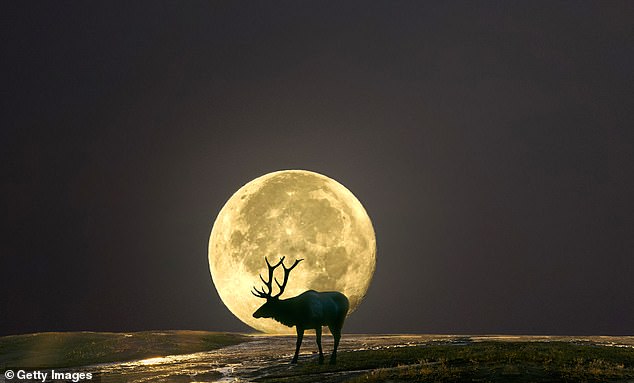Skywatchers are in for a treat when the summer’s first full moon creates an illusion in the night sky.
Although the moon reaches its full phase on Thursday at 4:36pm ET, it will appear most dramatic as it rises above the horizon after sunset, glowing with a striking orange hue and seeming larger than usual.
This is known as the ‘Moon Illusion,’ a rare visual phenomenon that plays a trick on the mind.
As the moon hovers near the horizon, the human brain compares it to nearby objects like trees, buildings, or mountains, making it appear far bigger than when it’s high overhead in the empty sky.
To experience the moon illusion for yourself, start by looking at the full moon, normally when it’s near the horizon.
Then, try viewing it through a cardboard tube to block out surrounding objects, which helps isolate the moon and reduces the illusion.
You can also look at the moon upside down by bending over and peering through your legs, or, if you have access to one, leaning backward while seated on a swing.
NASA says the moon typically looks orange or red near the horizon because Earth’s thick atmosphere scatters blue light, letting the warmer colors through, the same reason sunsets look red.

The rare illusion where the moon looks larger and orange, is expected to be visible right after the sunset, due to the combination of timing, position and distance from the sun
Thursday also marks as the moon’s farthest distance from the sun in 2025, as it comes just days after Earth hit aphelion, the point in its orbit farthest from the sun.
On average, the moon is about 92.9 million miles from the sun. But during the Buck Moon, it will be roughly 94.5 million miles away.
In summer, the sun takes a high path across the sky during the day. The moon, on the other hand, takes the opposite path at night. So instead of being high overhead, it moves in a lower arc closer to the horizon.
Because it stays low in the sky all night, you can see it for longer and from more places, even if you’re in a city or surrounded by buildings or trees.
So when people say this full moon gives some of the best views of the year, they’re talking about how easy and striking it is to watch, just because of where it travels in the sky.
The position of this moon will make it more special, as it will be unusually low in the sky at night. This is because a full moon always appears directly opposite to the sun.
Since the sun is still riding after the June’s summer solstice, which is the longest day time of the year, the moon will be hugging the horizon.
The moon’s unusual low path is a direct result of its 18.6-year lunar cycle, known as a lunistice, a point when the moon’s orbit tilts to its greatest angle relative to Earth’s equator.

The moon’s unusual low path is a direct result of its 18.6-year lunar cycle, known as a lunistice, a point when the moon’s orbit tilts to its greatest angle relative to Earth’s equator
This tilt means the moon rises and sets farther north or south on the horizon than usual, following a shallower or higher arc depending on the season.
NASA explains this occurs because the moon’s tilted orbit interacts with Earth’s own tilted axis and orbit around the sun, causing long-term shifts in the moon’s apparent trajectory.
The name ‘Buck Moon’ comes from a seasonal behavior in North America. July is when male deer, which is known as Buck, fully grows their new antlers.
Other Indigenous groups refer to it as the Thunder Moon, for the seasonal summer storms, or Salmon Moon and Raspberry Moon, tied to harvesting.
European names include the Hay Moon, Mead Moon, and Herb Moon, linked to midsummer farming and festivals.
While the name doesn’t describe the moon’s color, just like the previous month Strawberry Moon, the Buck Moon is known for its visual impact, especially when viewed from open fields, hilltops, or coastal areas with a clear southeast horizon.
No telescope or binoculars are necessary, any star-gazer can notice the size and color difference compared to a typical high-riding moon.
This moon’s low track and striking appearance are part of a long-term lunar rhythm.












